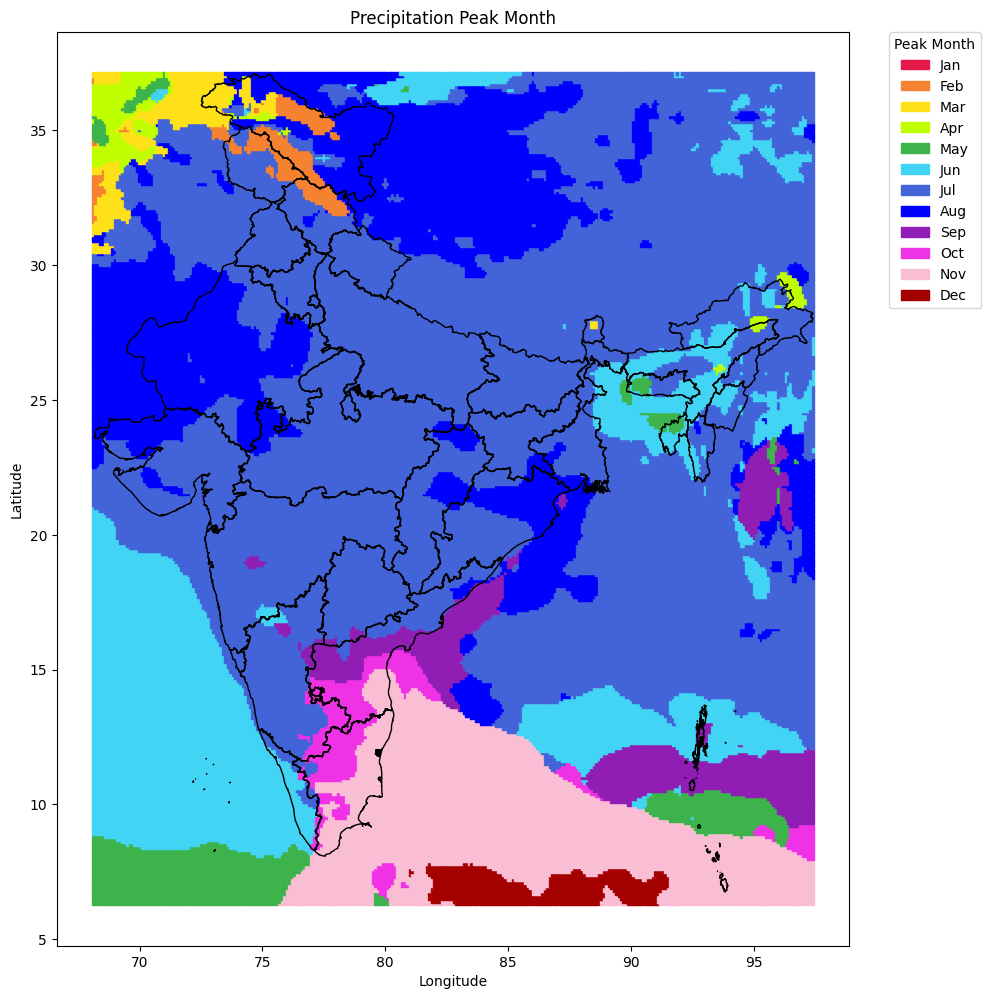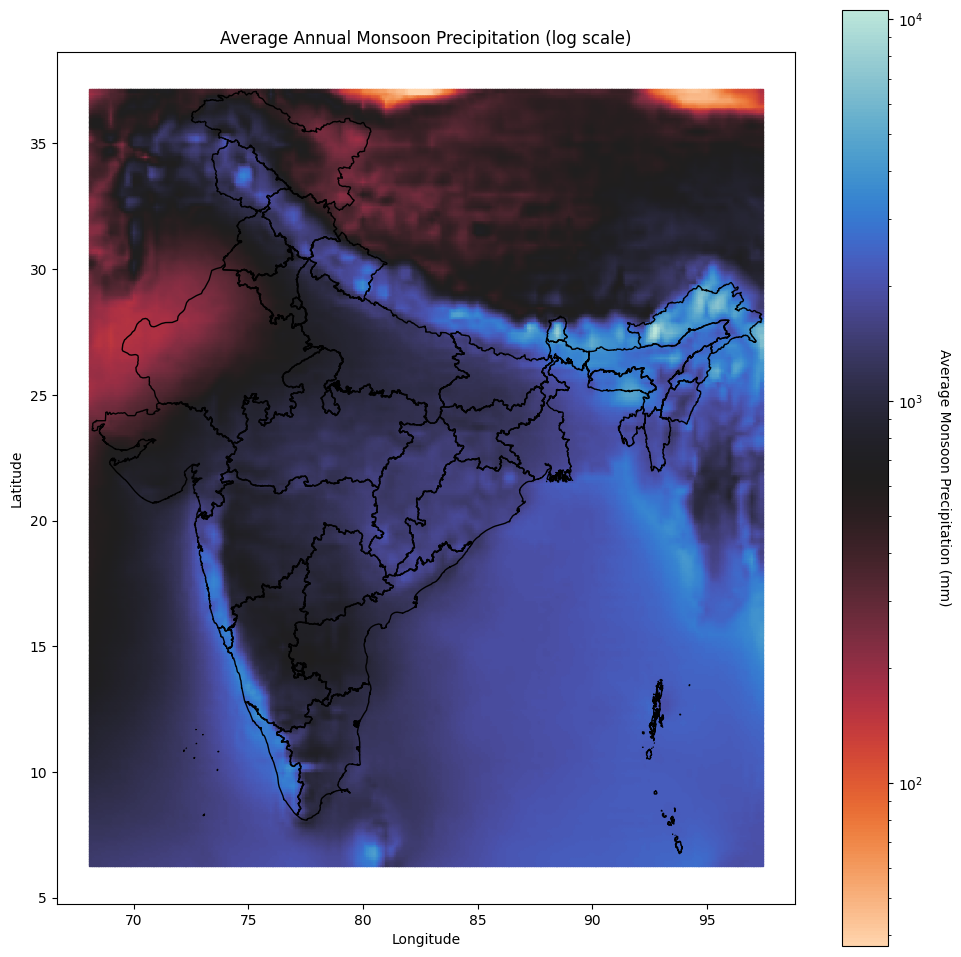Peak Month of Precipitation and Annual Rainfall Trends in India (2000–2024)#
In this notebook, we explore peak month of precipitation and average annual rainfall across the Indian Region from 2000 to 2024.
We use varunayan to extract monthly total precipitation and raw high-resolution precipitation data (latitude-longitude based) from the ERA5 climate reanalysis dataset.
We aim to:
Identify the month when rainfall peaks in each region
Visualize the peak rainfall month spatially across India
Map the average annual precipitation intensity across regions
This study can help identify the peak month of rainfall and its intensity, helpful for agriculture planners and climate enthusiasts.
Step 1: Extract ERA5 Total Precipitation for India#
We use the varunayan library to download monthly total precipitation (tp) for India from 2000 to 2024 at 0.1° resolution. Unit of precipitation is meters
import varunayan
varunayan.era5ify_bbox(
request_id='rainfall_Indian_region',
variables=['total_precipitation'],
start_date='2000-1-1',
end_date='2024-12-31',
north=37.1,
south=6.3,
east=97.4,
west=68.1,
frequency='monthly',
resolution=0.1
)
============================================================
STARTING ERA5 SINGLE LEVEL PROCESSING
============================================================
Request ID: rainfall_Indian_region
Variables: ['total_precipitation']
Date Range: 2000-01-01 to 2024-12-31
Frequency: monthly
Resolution: 0.1°
66c3fdfa3d3be513f9b637537cea8222.zip: 0%| | 0.00/14.5M [00:00<?, ?B/s]
9bad31012ee0ced1e981a10e7dd70505.zip: 0%| | 0.00/14.6M [00:00<?, ?B/s]
573eda0df6c6b84fa185d76238e2cbba.zip: 0%| | 0.00/14.7M [00:00<?, ?B/s]
Saving files to output directory: rainfall_Indian_region_output
Saved final data to: rainfall_Indian_region_output\rainfall_Indian_region_monthly_data.csv
Saved unique coordinates to: rainfall_Indian_region_output\rainfall_Indian_region_unique_latlongs.csv
Saved raw data to: rainfall_Indian_region_output\rainfall_Indian_region_raw_data.csv
============================================================
PROCESSING COMPLETE
============================================================
RESULTS SUMMARY:
----------------------------------------
Variables processed: 1
Time period: 2000-01-01 to 2024-12-31
Final output shape: (300, 3)
Total complete processing time: 325.50 seconds
First 5 rows of aggregated data:
tp year month
0 0.035323 2000 1
1 0.033074 2000 2
2 0.044064 2000 3
3 0.054206 2000 4
4 0.128884 2000 5
============================================================
ERA5 SINGLE LEVEL PROCESSING COMPLETED SUCCESSFULLY
============================================================
| tp | year | month | |
|---|---|---|---|
| 0 | 0.035323 | 2000 | 1 |
| 1 | 0.033074 | 2000 | 2 |
| 2 | 0.044064 | 2000 | 3 |
| 3 | 0.054206 | 2000 | 4 |
| 4 | 0.128884 | 2000 | 5 |
| ... | ... | ... | ... |
| 295 | 0.266228 | 2024 | 8 |
| 296 | 0.180782 | 2024 | 9 |
| 297 | 0.133635 | 2024 | 10 |
| 298 | 0.087241 | 2024 | 11 |
| 299 | 0.068181 | 2024 | 12 |
300 rows × 3 columns
Step 2: Processing Monthly Precipitation Data#
We begin by loading the raw monthly precipitation data extracted using varunayan. The dataset contains gridded precipitation values (tp) for each latitude-longitude point across India.
Steps performed:#
Monthly Aggregation
Extract the month and number of days in each entry.
Convert
tp(which is in meters/day) to total monthly precipitation in millimeters using:tp × days_in_month × 1000
Monthly Mean Grid Calculation
Group data by location and month, and compute the mean monthly precipitation over the years (2000–2024).
Pivot the data into a wide format — each row is a location, and each column is a month.
Peak Rainfall Month Detection
For each location, identify the month with the highest average rainfall.
Peak Month Precipitation & Total Annual Rainfall
Extract precipitation for the peak month at each location.
Calculate the sum of monthly precipitation values to estimate average annual rainfall.
The resulting dataframe (result) contains:
latitude,longitudepeak_month: the month when rainfall peakspeak_month_precip: precipitation during the peak monthavg_monsoon_precip: total average precipitation across all months
This data will be used for spatial visualizations in the next steps.
import pandas as pd
df_raw_prec = pd.read_csv('rainfall_Indian_region_output/rainfall_Indian_region_raw_data.csv')
import numpy as np
df_raw_prec['month'] = pd.to_datetime(df_raw_prec['date']).dt.month
df_raw_prec['date'] = pd.to_datetime(df_raw_prec['date'])
df_raw_prec['days_in_month'] = df_raw_prec['date'].dt.days_in_month
# Convert tp (precipitation in m/day) -> total monthly precipitation (in meters) -> total monthly precipitation (in mm)
df_raw_prec['tp'] = df_raw_prec['tp'] * df_raw_prec['days_in_month'] * 1000
monthly_mean = (
df_raw_prec.groupby(['latitude', 'longitude', 'month'])['tp']
.mean()
.reset_index()
)
pivot_df = monthly_mean.pivot_table(
index=['latitude', 'longitude'],
columns='month',
values='tp'
).reset_index()
pivot_df.columns.name = None
def detect_peak_month(row):
monthly_vals = row[2:].values
return np.argmax(monthly_vals) + 1
pivot_df['peak_month'] = pivot_df.apply(detect_peak_month, axis=1)
def get_peak_month_precip(row):
return row[int(row['peak_month'])]
pivot_df['peak_month_precip'] = pivot_df.apply(get_peak_month_precip, axis=1)
def avg_monsoon_total(row):
peak = row['peak_month']
monsoon_months = [1, 2, 3, 4, 5, 6, 7, 8, 9, 10, 11, 12]
return row[monsoon_months].sum()
pivot_df['avg_monsoon_precip'] = pivot_df.apply(avg_monsoon_total, axis=1)
result = pivot_df[['latitude', 'longitude', 'peak_month', 'peak_month_precip', 'avg_monsoon_precip']]
pivot_df.to_csv('rainfall_Indian_region_output/aggregated_rainfall_coord_wise.csv', index=False)
result
| latitude | longitude | peak_month | peak_month_precip | avg_monsoon_precip | |
|---|---|---|---|---|---|
| 0 | 6.3 | 68.1 | 5 | 205.738712 | 1408.417327 |
| 1 | 6.3 | 68.2 | 5 | 206.832029 | 1416.722255 |
| 2 | 6.3 | 68.3 | 5 | 207.830631 | 1422.048801 |
| 3 | 6.3 | 68.4 | 5 | 208.726855 | 1424.383828 |
| 4 | 6.3 | 68.5 | 5 | 209.740787 | 1427.170548 |
| ... | ... | ... | ... | ... | ... |
| 90841 | 37.1 | 97.0 | 7 | 27.636770 | 114.003676 |
| 90842 | 37.1 | 97.1 | 7 | 29.333958 | 122.099992 |
| 90843 | 37.1 | 97.2 | 7 | 31.622423 | 132.460268 |
| 90844 | 37.1 | 97.3 | 7 | 35.038696 | 148.160758 |
| 90845 | 37.1 | 97.4 | 7 | 38.926897 | 166.562461 |
90846 rows × 5 columns
peak_counts = pivot_df['peak_month'].value_counts(dropna=False).sort_index()
peak_stats = pd.DataFrame({
'month': peak_counts.index,
'count': peak_counts.values
})
peak_stats['month'] = peak_stats['month'].apply(lambda x: int(x) if pd.notna(x) else 'NaN')
print(peak_stats)
month count
0 2 785
1 3 1091
2 4 770
3 5 2902
4 6 12318
5 7 44032
6 8 14210
7 9 3488
8 10 1493
9 11 8671
10 12 1086
Step 3: Preparing State Boundaries for Mapping#
To overlay accurate state boundaries on our precipitation maps, we use a utility script to download and clean a detailed India state GeoJSON.
We fetch a script (
geojson_splitter.py) from a GitHub Gist which contains a function to:Split and clean multi-geometry GeoJSON files.
Ensure geometries are valid and can be plotted reliably.
The script is executed directly using
exec().We then call
split_and_clean_states()on an India state boundary GeoJSON to:Split complex geometries (e.g., MultiPolygons).
Save each state as a clean individual GeoJSON file for seamless overlay on maps.
These cleaned files will be used to draw precise administrative boundaries when plotting rainfall maps across India.
import requests
gist_url = "https://gist.githubusercontent.com/JaggeryArray/ab0f0ba05a65995702369fa12051ff1d/raw/3847b34e5e9105a11c1613f37dbe8330a6d4d8fa/geojson_splitter.py"
response = requests.get(gist_url)
code = response.text
exec(code)
split_and_clean_states("https://gist.githubusercontent.com/JaggeryArray/fa31964eedb0c2da023c9485772f911a/raw/02c0644de34fbae9dbac2ba0496a00772a2c28cd/india_map_states.geojson", debug_mode=False)
Downloading GeoJSON from URL...
Reading master GeoJSON...
Found 36 features across 36 unique states
Performing initial geometry cleaning...
Processing: A & N Islands
Cleaning geometries...
Attempting advanced repair for A & N Islands...
Saved: split_geojsons\A_N_Islands.geojson (1 features)
Processing: Andhra Pradesh
Cleaning geometries...
Saved: split_geojsons\Andhra_Pradesh.geojson (1 features)
Processing: Arunachal Pradesh
Cleaning geometries...
Saved: split_geojsons\Arunachal_Pradesh.geojson (1 features)
Processing: Assam
Cleaning geometries...
Saved: split_geojsons\Assam.geojson (1 features)
Processing: Bihar
Cleaning geometries...
Saved: split_geojsons\Bihar.geojson (1 features)
Processing: Chandigarh
Cleaning geometries...
Saved: split_geojsons\Chandigarh.geojson (1 features)
Processing: Chhattisgarh
Cleaning geometries...
Saved: split_geojsons\Chhattisgarh.geojson (1 features)
Processing: DNHDD
Cleaning geometries...
Saved: split_geojsons\DNHDD.geojson (1 features)
Processing: Delhi
Cleaning geometries...
Saved: split_geojsons\Delhi.geojson (1 features)
Processing: Goa
Cleaning geometries...
Saved: split_geojsons\Goa.geojson (1 features)
Processing: Gujarat
Cleaning geometries...
Saved: split_geojsons\Gujarat.geojson (1 features)
Processing: Haryana
Cleaning geometries...
Saved: split_geojsons\Haryana.geojson (1 features)
Processing: Himachal Pradesh
Cleaning geometries...
Saved: split_geojsons\Himachal_Pradesh.geojson (1 features)
Processing: Jammu & Kashmir
Cleaning geometries...
Saved: split_geojsons\Jammu_Kashmir.geojson (1 features)
Processing: Jharkhand
Cleaning geometries...
Saved: split_geojsons\Jharkhand.geojson (1 features)
Processing: Kerala
Cleaning geometries...
Saved: split_geojsons\Kerala.geojson (1 features)
Processing: Ladakh
Cleaning geometries...
Saved: split_geojsons\Ladakh.geojson (1 features)
Processing: Lakshadweep
Cleaning geometries...
Saved: split_geojsons\Lakshadweep.geojson (1 features)
Processing: Maharashtra
Cleaning geometries...
Saved: split_geojsons\Maharashtra.geojson (1 features)
Processing: Manipur
Cleaning geometries...
Saved: split_geojsons\Manipur.geojson (1 features)
Processing: Meghalaya
Cleaning geometries...
Saved: split_geojsons\Meghalaya.geojson (1 features)
Processing: Mizoram
Cleaning geometries...
Saved: split_geojsons\Mizoram.geojson (1 features)
Processing: Nagaland
Cleaning geometries...
Saved: split_geojsons\Nagaland.geojson (1 features)
Processing: Odisha
Cleaning geometries...
Saved: split_geojsons\Odisha.geojson (1 features)
Processing: Puducherry
Cleaning geometries...
Saved: split_geojsons\Puducherry.geojson (1 features)
Processing: Punjab
Cleaning geometries...
Saved: split_geojsons\Punjab.geojson (1 features)
Processing: Rajasthan
Cleaning geometries...
Saved: split_geojsons\Rajasthan.geojson (1 features)
Processing: Sikkim
Cleaning geometries...
Saved: split_geojsons\Sikkim.geojson (1 features)
Processing: Tamil Nadu
Cleaning geometries...
Saved: split_geojsons\Tamil_Nadu.geojson (1 features)
Processing: Telangana
Cleaning geometries...
Saved: split_geojsons\Telangana.geojson (1 features)
Processing: Tripura
Cleaning geometries...
Saved: split_geojsons\Tripura.geojson (1 features)
Processing: Uttarakhand
Cleaning geometries...
Saved: split_geojsons\Uttarakhand.geojson (1 features)
Processing: Uttar Pradesh
Cleaning geometries...
Saved: split_geojsons\Uttar_Pradesh.geojson (1 features)
Processing: West Bengal
Cleaning geometries...
Saved: split_geojsons\West_Bengal.geojson (1 features)
Processing: Karnataka
Cleaning geometries...
Saved: split_geojsons\Karnataka.geojson (1 features)
Processing: Madhya Pradesh
Cleaning geometries...
Saved: split_geojsons\Madhya_Pradesh.geojson (1 features)
============================================================
FINAL SUMMARY:
Successfully saved: 36 states
Skipped due to issues: 0 -> []
Output directory: split_geojsons
def setup_matplotlib():
try:
import matplotlib.pyplot as plt
except ImportError:
raise ImportError(
"Matplotlib is not installed. Install it with: pip install matplotlib"
)
plt.rcParams["figure.dpi"] = 300
plt.rcParams["savefig.dpi"] = 300
plt.rcParams["font.family"] = "sans-serif"
plt.rcParams["font.sans-serif"] = ["Arial"]
plt.rcParams["axes.labelweight"] = "normal"
plt.rcParams["mathtext.fontset"] = "custom"
plt.rcParams["mathtext.rm"] = "Arial"
plt.rcParams["mathtext.it"] = "Arial:italic"
plt.rcParams["mathtext.bf"] = "Arial:bold"
Mapping Peak Precipitation Month Across India#
We now visualize the month of peak rainfall for every coordinate in the dataset.
How it works:#
Each location’s peak precipitation month (1–12) is already computed in the earlier step.
We assign a distinct color to each month using a custom colormap.
A scatter plot of all grid points is created, with color-coded markers representing the peak rainfall month.
State boundaries (from cleaned GeoJSONs) are overlaid for better spatial reference.
A clear legend is added to map colors to month names.
This plot helps reveal the spatial variation in monsoon timing — for example, areas where the monsoon arrives early vs. those where it peaks later.
import matplotlib.pyplot as plt
import geopandas as gpd
import pandas as pd
import glob
import matplotlib.patches as mpatches
import numpy as np
month_colors = {
0: (0.901, 0.098, 0.294), # Jan
1: (0.961, 0.510, 0.192), # Feb
2: (1.000, 0.882, 0.098), # Mar
3: (0.749, 1.000, 0.000), # Apr
4: (0.235, 0.706, 0.294), # May
5: (0.259, 0.831, 0.957), # Jun
6: (0.263, 0.388, 0.847), # Jul
7: (0.000, 0.000, 1.000), # Aug
8: (0.569, 0.118, 0.706), # Sep
9: (0.941, 0.196, 0.902), # Oct
10: (0.980, 0.745, 0.831), # Nov
11: (0.643, 0.000, 0.000), # Dec
}
def get_color(row):
base = month_colors[int(row['peak_month']) - 1] # color for month
return (base[0], base[1], base[2], 1)
result['plot_color'] = result.apply(get_color, axis=1)
plt.figure(figsize=(10, 12))
plt.scatter(
result['longitude'], result['latitude'],
c=result['plot_color'],
s=3,
marker='s'
)
# Overlay all state boundaries
for path in glob.glob("split_geojsons/*.geojson"):
try:
state_gdf = gpd.read_file(path)
if state_gdf.empty:
print(f"Skipping {path}: empty file.")
continue
# Remove invalid geometries
state_gdf = state_gdf[state_gdf.is_valid & state_gdf.geometry.notnull()]
if state_gdf.empty:
print(f"Skipping {path}: all geometries invalid or null.")
continue
bounds = state_gdf.total_bounds
if np.any(np.isnan(bounds)) or np.any(np.isinf(bounds)):
print(f"Skipping {path}: invalid bounds.")
continue
state_gdf.boundary.plot(ax=plt.gca(), color='black', linewidth=1)
except Exception as e:
print(f"Error reading or plotting {path}: {e}")
plt.xlabel("Longitude")
plt.ylabel("Latitude")
plt.title("Precipitation Peak Month")
# Month names for legend
month_names = {
0: 'Jan', 1: 'Feb', 2: 'Mar', 3: 'Apr',
4: 'May', 5: 'Jun', 6: 'Jul', 7: 'Aug',
8: 'Sep', 9: 'Oct', 10: 'Nov', 11: 'Dec'
}
# Create legend handles
legend_handles = [
mpatches.Patch(color=month_colors[m], label=month_names[m])
for m in range(12)
]
# Add legend box (outside plot or inside based on your preference)
plt.legend(
handles=legend_handles,
title="Peak Month",
bbox_to_anchor=(1.05, 1), # move outside right
loc='upper left',
borderaxespad=0.,
frameon=True
)
plt.tight_layout()
plt.show()
C:\Users\Atharva Jagtap\AppData\Local\Temp\ipykernel_19412\945228509.py:29: SettingWithCopyWarning:
A value is trying to be set on a copy of a slice from a DataFrame.
Try using .loc[row_indexer,col_indexer] = value instead
See the caveats in the documentation: https://pandas.pydata.org/pandas-docs/stable/user_guide/indexing.html#returning-a-view-versus-a-copy
result['plot_color'] = result.apply(get_color, axis=1)

Mapping Average Annual Monsoon Precipitation#
In this step, we create a spatial heatmap of average annual monsoon precipitation across India.
How it’s done:#
Using the
avg_monsoon_precipvalues computed earlier (in mm).Creating a scatter plot where each point represents a grid cell and is color-coded by rainfall intensity.
The color scale is based on a logarithmic normalization, which helps in better visual contrast across regions with low vs. high rainfall.
The
icefirecolormap from seaborn is used for an intuitive blue-to-red transition.We overlay state boundaries for better geographic context.
This plot helps reveal the spatial variation in annual rainfall.
import matplotlib.pyplot as plt
import geopandas as gpd
import pandas as pd
import glob
import matplotlib.patches as mpatches
import numpy as np
from matplotlib.colors import Normalize, LogNorm
import matplotlib.cm as cm
import seaborn as sns
plt.figure(figsize=(10, 12))
cmap = 'icefire_r'
min_val = result['avg_monsoon_precip'].min()
max_val = result['avg_monsoon_precip'].max()
if min_val <= 0:
offset = 0.1
print(f"Warning: Found values <= 0. Adding offset of {offset}")
norm = LogNorm(vmin=max(min_val + offset, 0.1), vmax=max_val)
else:
norm = LogNorm(vmin=min_val, vmax=max_val)
scatter = plt.scatter(
result['longitude'], result['latitude'],
c=result['avg_monsoon_precip'],
cmap=cmap,
norm=norm,
s=3,
marker='s'
)
# Add colorbar
cbar = plt.colorbar(scatter, shrink=0.8)
cbar.set_label('Average Monsoon Precipitation (mm)', rotation=270, labelpad=20)
# Overlay all state boundaries
for path in glob.glob("split_geojsons/*.geojson"):
try:
state_gdf = gpd.read_file(path)
if state_gdf.empty:
print(f"Skipping {path}: empty file.")
continue
# Remove invalid geometries
state_gdf = state_gdf[state_gdf.is_valid & state_gdf.geometry.notnull()]
if state_gdf.empty:
print(f"Skipping {path}: all geometries invalid or null.")
continue
bounds = state_gdf.total_bounds
if np.any(np.isnan(bounds)) or np.any(np.isinf(bounds)):
print(f"Skipping {path}: invalid bounds.")
continue
state_gdf.boundary.plot(ax=plt.gca(), color='black', linewidth=1)
except Exception as e:
print(f"Error reading or plotting {path}: {e}")
# Final touches
plt.xlabel("Longitude")
plt.ylabel("Latitude")
plt.title("Average Annual Monsoon Precipitation (log scale)")
plt.tight_layout()
plt.show()

